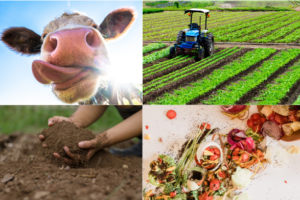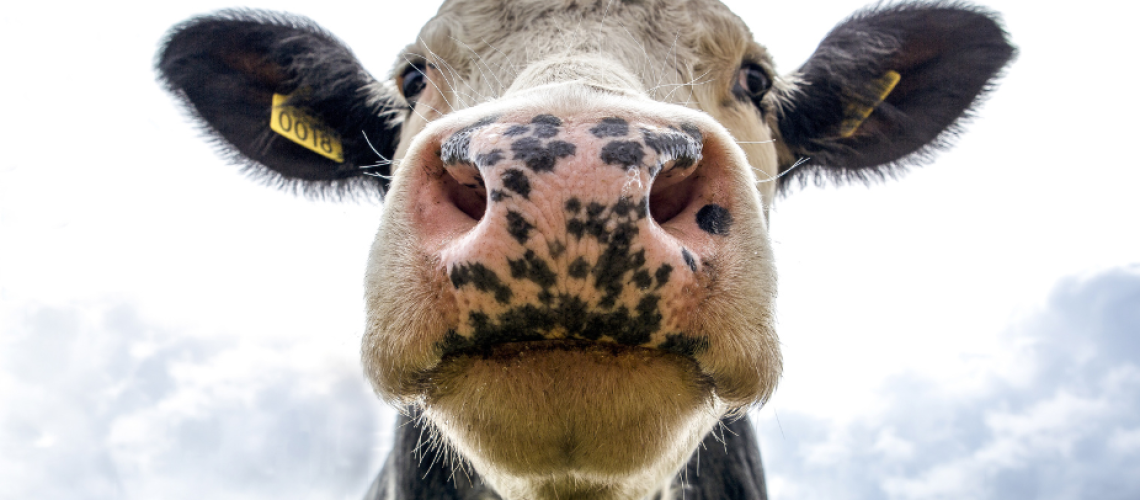Guest Post by Julieta Juncosa Calahorrano, 2022-2023 Sustainability Leadership Fellow, and Ph.D. Candidate in the Department of Atmospheric Science at Colorado State University
 Growing up in Latin America, food was at the center of many family gatherings. Throughout the world, food and cooking are intertwined with our culture, traditions, and sense of belonging. But in recent years, many of us have asked ourselves the question: what role does the food I eat play in climate change? Scientists have become more aware of the impacts of agriculture on Earth’s changing climate. It is estimated that agriculture was responsible for 11% of the total U.S. greenhouse gas emissions in the year 2020. Those emissions come from farm equipment (e.g., trucks), ruminant animals (e.g., cattle, sheep, goats), food waste, and soil emissions. Since food is essential for any human being to survive, it is not going away. Food can also mean so much more than just nutrients and vitamins to each of us. Finding sustainable ways of producing the food we need and enjoy is essential for our future.
Growing up in Latin America, food was at the center of many family gatherings. Throughout the world, food and cooking are intertwined with our culture, traditions, and sense of belonging. But in recent years, many of us have asked ourselves the question: what role does the food I eat play in climate change? Scientists have become more aware of the impacts of agriculture on Earth’s changing climate. It is estimated that agriculture was responsible for 11% of the total U.S. greenhouse gas emissions in the year 2020. Those emissions come from farm equipment (e.g., trucks), ruminant animals (e.g., cattle, sheep, goats), food waste, and soil emissions. Since food is essential for any human being to survive, it is not going away. Food can also mean so much more than just nutrients and vitamins to each of us. Finding sustainable ways of producing the food we need and enjoy is essential for our future.
As an atmospheric chemist, I want to better understand the emissions of agriculture to the atmosphere. In particular, my research focuses on the emissions of reactive nitrogen (N) from animal farming. Imagine nitrogen molecules at a dance party. There are many types of these molecules. Some are extroverts — they do not stop dancing and interacting with the others all night long. These extroverted nitrogen molecules are called reactive nitrogen. Others are introverts — they can just enjoy a drink without the need to interact with anyone else. These are called inert molecules. Remember, there is a range of molecules at the party — all sorts of different types can coexist. Agriculture, in particular animal farming, is a source of at least two types of these N molecules. The first one is nitrous oxide (N2O). N2O would be comfortable sitting on a couch and not interacting much with anyone. It loves to absorb infrared radiation, the same kind that heats our planet, and it can absorb this radiation 235 times more efficiently than its friend, carbon dioxide (CO2). The good news here is that we only find a few of these in the party. The bad news is that they won’t leave for a very long time. Then, we have ammonia (NH3). This one is the dancer, prancer, and talker of the night. And there are a lot of these social NH3 at the party — and I mean a lot! NH3 can be found either as part of a particle or as a gas molecule. Because NH3 is so hyper, it has been very hard to get a hold of (or in this case, measure). It gets to the party, hangs around for only a little while, and then goes away. Scientists worldwide are making huge strides in measuring it and understanding what drives emissions of NH3 to the atmosphere from animal farming. Finally, allow me to introduce a friend of the N-containing nitrogen molecules to the party: methane (CH4). This one is relevant because it is also emitted from animal farming, as well as from oil and gas production. CH4 absorbs light and warms our planet, similar to N2O and CO2. The big problem with CH4 is that way more of them are coming to the party than N2O. And even though they stay for a shorter time than N2O or CO2, in this case, their impact beats their shorter stay.
I have mentioned only a couple of molecules that are at the party. The truth is that they co-exist with thousands of other molecules and interact with many of them, depending on which side of the extrovert-introvert spectrum they are. For example, our extroverted friend NH3 is very smelly, and it can mix with acid molecules produced by vehicle emissions and combustion sources. When they find each other, they will form particles which are harmful for human health. NH3 can also travel and dissolve in precipitation, reaching the ground as rain or snow far away from where it was emitted. This can have negative impacts on ecosystem health. The introverted party-goers, CH4 and N2O, are less prone to interact with other molecules, but they do interact with radiation, which has a great impact on the Earth’s climate.
Since food and food production are crucial for human survival, farming is not going anywhere. After finishing my data collection, I am left with much more knowledge about how animal farming affects nitrogen emissions. I am also left with more questions, especially for the agriculture community. I wonder what their questions are for us. Is there any more information that atmospheric scientists can provide this community? What are their questions for policy makers and regulators? What are their messages and questions for their consumers? I am also left with a desire to learn from farmers’ knowledge, especially those in charge of small farms.
 The path towards a livable Earth is a matter that pertains to all of us. Some might decide to stop eating meat, others might decide to bike to the office, others might make an intentional decision to waste less food and make it available to those that do not have enough, and others might work toward government policies that have more positive impacts on Earth’s climate. The point is, we all can do something. At the very least, we can speak up, talk to each other, and keep pushing for larger, more impactful changes that will make our lifestyles more harmonious with Earth’s resources.
The path towards a livable Earth is a matter that pertains to all of us. Some might decide to stop eating meat, others might decide to bike to the office, others might make an intentional decision to waste less food and make it available to those that do not have enough, and others might work toward government policies that have more positive impacts on Earth’s climate. The point is, we all can do something. At the very least, we can speak up, talk to each other, and keep pushing for larger, more impactful changes that will make our lifestyles more harmonious with Earth’s resources.






